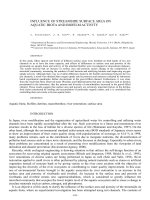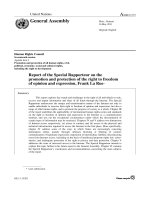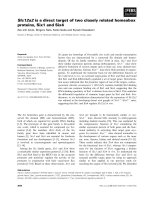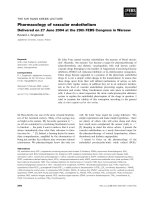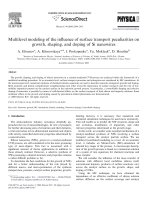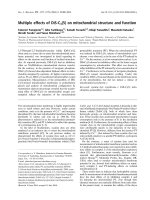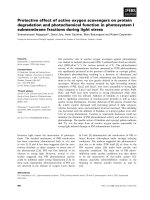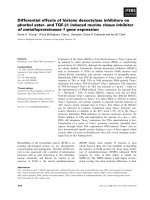Direct observations of nickel silicide formation on (100) si and si0 75ge0 25 substrates using in situ transmission electron microscopy
Bạn đang xem bản rút gọn của tài liệu. Xem và tải ngay bản đầy đủ của tài liệu tại đây (8.24 MB, 151 trang )
DIRECT OBSERVATIONS OF NICKEL SILICIDE
FORMATION ON (100) Si AND Si0.75Ge0.25 SUBSTRATES
USING IN-SITU TRANSMISSION ELECTRON
MICROSCOPY
RAMESH NATH S/O PREMNATH
(B.Sc.(Hons.), NUS)
A THESIS SUBMITTED
FOR THE DEGREE OF MASTER OF SCIENCE
DEPARTMENT OF MATERIALS SCIENCE
NATIONAL UNIVERSITY OF SINGAPORE
2004
Acknowledgements
I would like to express my utmost gratitude and thanks to my supervisor
Professor Mark Yeadon for this project accomplishment. Without his patient
guidance, this work will not have been possible. From my early days of ignorance, he
had been there to provide knowledge, mentorship and assistance whenever difficulties
are encountered. I am also grateful for Prof. Yeadon’s invaluable coaching in the
handling of his precious transmission electron microscope and the knowledge of the
operating techniques and little tricks here and there that he transferred to the me. It is
a joy to work with him in the laboratory and get to know him as a friend.
I am also deeply indebted to Dr. Christopher Boothroyd for his mentorship and
guidance in helping me better understand the principles of the transmission electron
microscope and the Gatan Image Filter. The long discussions we had over tea have
definitely helped shaped me to be a better microscopist.
I would also like to thank Dr. Lap Chan (CSM) for being an excellent teacher
and facilitator who has helped to put this project together.
I must particularly express my most sincere gratitude to my colleagues and
also my friends, Dr. Foo Yong Lim and Soo Chi Wen, for their advice, understanding
and help along the way.
I would also like to thank my loved ones who were very supportive of what
could be a misadventure, but happily, turned out to be a great learning experience and
project.
Finally, I would like to thank Professor Chow Gan Moog, Professor Chua Soo
Jin and Professor Alfred Huan for the provision of the laboratory facilities, which
made this project possible.
i
Table of contents
Acknowledgements………………………………………………………………… i
Table of contents…………………………………………………………………… ii
Summary…..……………………………………………………………………….. vi
List of tables………………………………………………………………………...viii
List of figures……………………………………………………………………......ix
Nomenclature……………………………………………………………………… xvi
List of publications...……………………………………………………………….xviii
1
Introduction................................................................................................. 1
2
Literature Review and Thin Films .............................................................. 5
2.1
Silicon-germanium technology........................................................... 5
2.1.1
Introduction to SiGe technology..................................................... 5
2.1.2
Si1-xGex growth issues ..................................................................... 7
2.2
Silicide technology.............................................................................. 9
2.2.1
Introduction to silicides................................................................... 9
2.2.2
Formation of silicides for technological applications................... 11
2.2.3
Requirements for silicides in silicon integrated circuits ............... 13
2.2.4
Comparison of nickel silicide with other silicides........................ 15
2.2.4.1
Titanium disilicide .............................................................. 15
2.2.4.2
Cobalt disilicide .................................................................. 16
2.2.4.3
Nickel monosilicide ........................................................... 19
2.2.4.4
Nickel silicidation on Si1-xGex substrates........................... 22
2.3
2.3.1
Principles of thin films...................................................................... 23
Mechanism for the formation of thin film nickel silicide phases . 24
ii
2.3.2
Agglomeration of thin films.......................................................... 27
References ....................................................................................................... 29
3
Principles of transmission electron microscopy ...................................... 32
3.1
Introduction to transmission electron microscopy............................ 32
3.2
Important electron interactions with the sample in TEM ................. 33
3.3
Diffraction......................................................................................... 36
3.3.1
Theory of electron diffraction....................................................... 36
3.3.2
Structure factor.............................................................................. 43
3.3.3
Selected area electron diffraction.................................................. 45
3.4
Bright and dark field imaging ........................................................... 47
3.5
Basic optics operation of JEM 2000V TEM..................................... 49
References ....................................................................................................... 51
4
Experimental setup.................................................................................... 52
4.1
The MERLION system ..................................................................... 52
4.2
Preparation of Si (100) substrates ..................................................... 55
4.3
Preparation of Si0.75Ge0.25 (100) substrates ....................................... 56
4.4
Nickel deposition .............................................................................. 58
4.5
Resistive annealing ........................................................................... 59
4.6
Observation and data collection........................................................ 60
4.6.1
Gatan DualView 780 digital camera............................................. 61
4.6.2
Gatan Image Filter ........................................................................ 61
4.6.2.1
Theory of operation............................................................. 62
iii
4.6.2.2
Basic concepts of EELS ...................................................... 64
4.6.2.3
Uses of EELS Data ............................................................. 66
4.6.2.4
EFTEM................................................................................ 68
4.6.2.5
Selecting an energy loss...................................................... 68
References ....................................................................................................... 69
5
Results and discussion I: Ni on Si (100)................................................... 70
5.1
Ni on clean Si (100) .......................................................................... 71
5.1.1
Preliminary inspection of clean Si (100) ...................................... 71
5.1.2
Nickel deposition on clean Si (100).............................................. 72
5.1.3
Annealing of the 12nm Ni film on clean Si (100) ........................ 73
5.2
Ni on oxide-covered Si (100)............................................................ 87
5.2.1
Preliminary inspection of oxide-covered Si (100) ........................ 87
5.2.2
Nickel deposition on oxide-covered Si (100) ............................... 88
5.2.3
Annealing of the 12nm Ni film on oxide-covered Si (100) .......... 88
5.2
Summary of Chapter 5 ...................................................................... 92
References ....................................................................................................... 93
6
Results and discussion II: Ni on relaxed Si0.75Ge0.25 (100)...................... 95
6.1
Preliminary inspection of relaxed Si0.75Ge0.25 (100) ........................ 96
6.2
Nickel deposition on relaxed Si0.75Ge0.25 (100) ............................... 99
6.3
Annealing of the 12nm Ni film on relaxed Si0.75Ge0.25 (100) ........ 100
6.4
Summary of Chapter 6 .................................................................... 112
References ..................................................................................................... 113
iv
7
Conclusion .............................................................................................. 115
Appendix: Indexing of SAED patterns......................................................... 118
A.1
Identification of major spots and calibration of SAED patterns..... 118
A.1.1 Step one....................................................................................... 118
A.1.2 Step two and three....................................................................... 120
A.2
Calibration and indexing of SAED pattern in Figure 5.1 (b).......... 121
A.3
Indexing of SAED pattern in Figure 5.2 (b) ................................... 124
A.4
Indexing of SAED pattern in Figure 5.4 (a) ................................... 125
A.5
Indexing of SAED pattern in Figure 5.4 (c) ................................... 128
A.6
Indexing of SAED pattern in Figure 5.15 (b) ................................. 131
v
Summary
Recent success in the growth technology of Si1-xGex epitaxial thin films has found
its potential in high-speed electronic device applications for ultra large-scale integrated
(ULSI) circuits, such as complementary metal-oxide semiconductor (CMOS) technology.
One of the requirements for the device structures is to form a good ohmic contact that
will not degrade the device performance, where metal silicides have played a key role. It
is anticipated that they will continue to be used with strained-Si and Si1-xGex device
technologies. There is considerable interest in the use of NiSi due to its lower silicon
consumption and one-step low temperature of formation. A severe disadvantage of NiSi
thin layers, however, is the propensity for agglomeration above ~400ºC and
transformation to the high-resistivity nickel disilicide phase between 650 and 750ºC.
In this work, a modified TEM for in-situ studies of the thermal reaction of 12nm
Ni thin films on (100) Si and relaxed Si0.75Ge0.25 substrates was used. Real-time direct
observations of the formation and agglomeration of nickel monosilicide films, followed
by the mechanism of the nucleation of NiSi2 at higher temperatures in both cases were
made. In the case of Ni on (100) Si, two sets of experiments were carried out, namely on
clean and oxide-covered Si (100). For the Ni on clean Si experiment, a uniform and
pinhole-free but highly strained polycrystalline thin NiSi film was formed at 300ºC. The
onset of agglomeration of the NiSi film was observed at a temperature range of 400500ºC which became more severe at higher temperatures to form isolated NiSi islands.
The nucleation of NiSi2 was first observed at 650ºC, occurring at the edges of the NiSi
islands, at the free surface of the substrate. Observations are understood from a
consideration of the reduction in the free energy barrier for nucleation of NiSi2 at the free
vi
surface of the film where enhanced strain relaxation can occur. For the Ni on oxidecovered Si (100) experiment, epitaxial NiSi2 was the first silicide phase to form at 200ºC
with the coexistence of the NiSi and NiSi2 phases in the temperature range of 200-650ºC.
At temperatures above 650ºC, the NiSi layer was observed to be entirely consumed to
form NiSi2. Observations suggest that the native oxide layer acts as a diffusion barrier,
mediating the flux of Ni atoms to the Si surface. This promotes direct nucleation of NiSi2,
at temperatures as low as 150ºC.
In the case of Ni on (100) Si1-xGex, the agglomeration process of the monosilicide
film started to occur at 400°C and became more severe at higher temperatures. EELS and
EFTEM analysis at this temperature revealed that Ge atoms from the monosilicide islands
had segregated to the grain boundaries and areas of bare substrate making these areas Gerich. The formation of NiSi2 islands was first observed after heating in the temperature
range of 940-960°C for several minutes, which is ~300°C higher than in the case of Ni on
Si (100). This is attributed to the reduced free energy of formation of NiSi2 in the
presence of Ge.
vii
List of tables
Table 2.1: ITRS 2001 update of relevant data concerning silicides............................. 14
Table 2.2: Comparison of physical properties of TiSi2, CoSi2 and NiSi ..................... 21
Table A.1: Ratio of square of d-spacing between Si (200) and Si (220) planes. ....... 120
Table A.2: Showing the comparison and analysis of the calculated d-spacings of the
Ni rings with d-spacing from a standard JCPDS file 04-0850.............................. 125
Table A.3: Showing the comparison and analysis of the calculated d-spacings of
Figure 5.4 (a) spot pattern with d-spacings from a standard JCPDS file 38-0844 127
Table A.4: Showing the calculated angles between planes of atoms with d-spacings
matching closely with experimental data in Figure 5.4 (a). .................................. 127
Table A.5: Showing the comparison and analysis of the calculated d-spacings of
Figure 5.4 (c) spot pattern with d-spacings from a standard JCPDS file 38-0844 129
Table A.6: Showing the calculated angles between planes of atoms with d-spacings
matching closely with experimental data in Figure 5.4 (c)................................... 130
Table A.7: Showing the comparison and analysis of the calculated d-spacings of
Figure 5.15 (b) spot pattern with d-spacings from a standard JCPDS file 38-0844
............................................................................................................................... 132
Table A.8: Showing the calculated angles between planes of atoms with d-spacings
matching closely with experimental data in Figure 5.15 (b) ................................ 132
viii
List of figures
Figure 2.1: Polycide and Salicide processes: (a) Polycide structure, (b) Salicide
structure............................................................................................................. 12
Figure 3.1: Diagrammatic representation of the interaction between a beam of highenergy incident electrons and a specimen. A number of interactions take place.
Transmission electron microscopy (TEM) uses unscattered, inelastically
scattered, and narrow-angle elastically scattered electrons .............................. 34
Figure 3.2: Defining the incident and diffracted vectors. K represents difference
between incident (kI) and (kD) wave vectors.................................................... 38
Figure 3.3: Showing the constructive and destructive interference of two wave fronts
........................................................................................................................... 39
Figure 3.4: Ewald sphere construction showing the sphere superimposed on the
reciprocal lattice points. Points that intersect the sphere will satisfy the Bragg
condition and will appear in the diffraction pattern.......................................... 40
Figure 3.5: (a) Relationship between diffracted intensity and excitation error s. (b)
Illustrating the relationship between diffracted intensity and excitation error,
where relrods intercepted by the Ewald sphere further away from the origin O,
are lower in intensity due to excitation error .................................................... 42
Figure 3.6: (a) The insertion of a selected area aperture allows the formation of the
diffraction pattern only from the selected area. (b) Schematic of the formation
and geometry of a diffraction spot in relation to the transmitted beam ............ 46
Figure 3.7: (a) Objective aperture selecting the on-axis transmitted beam to form a
bright field image. (b) Objective aperture selecting the off-axis diffracted
ix
beam to form a displaced dark field image. (c) Another method to form a dark
field image with the objective aperture selecting the on-axis diffracted beam. 48
Figure 3.8: Schematic of condenser and objective lens of JEOL 2000V ................... 49
Figure 3.9: Schematic of image forming system in JEOL 2000V .............................. 50
Figure 4.1: The MERLION system.............................................................................. 53
Figure 4.2: Steps involved in preparing Si (100) substrates ........................................ 55
Figure 4.3: Steps involved in preparing the Si0.75Ge0.25 (100) substrates .................... 57
Figure 4.4: The UHV evaporator EFM3 as attached to the MERLION system.......... 58
Figure 4.5: Graph of Current input versus Temperature reading from the Si substrate
(the temperatures are measured using a pyrometer), x-axis indicates current,
each interval is 0.1, unit: ampere; y axis indicates temperature, each interval is
50, unit: degree Celsius..................................................................................... 60
Figure 4.6: The Gatan DualView system as attached to the MERLION system......... 61
Figure 4.7: The Gatan Image Filter system as attached to the MERLION system...... 62
Figure 4.8: Schematic of the Gatan Image Filter ......................................................... 63
Figure 4.9: Showing the electron shells and transitions............................................... 65
Figure 5.1: Showing (a) EELS spectrum, (b) SAD and bright field image of a clean Si
(100) substrate................................................................................................... 72
Figure 5.2: Corresponding (a) bright field image and (b) SAED for as deposited
12nm Ni on Si (100) ......................................................................................... 73
Figure 5.3: Strain contrast is observed in (a) bright field and (b) dark field image with
the corresponding SAED pattern in (c) showing Si and NiSi reflections......... 74
x
Figure 5.4: The SAED patterns in (a) and (c) shows an example of two different
orientation of NiSi grains with respect to the Si (100) substrate. The red and
white dotted line in both SAED patterns represents the reflections of Si and
NiSi phase respectively. The simulated diffraction pattern indexed with NiSi
reflections are shown in (b) and (d) respectively.............................................. 76
Figure 5.5: Thermal grooving starts to occur at grain boundaries in (a) indicating the
onset of agglomeration. This is followed by liquid-like void growth exposing
the Si substrate in (b) at 400-500ºC. ................................................................. 77
Figure 5.6: Showing severe agglomeration occurring in (a) and (b). The nucleation of
the new phase was observed at ‘N’ in (c) and seen propagating through island
‘I’ until the reaction terminated in (f) ............................................................... 78
Figure 5.7: Images (a) - (e), captured from video recording, illustrates the
transformation of island ‘I’ into an island with two grain boundaries. The time
scale of the movement of the boundaries (indicated by the red doted lines) as it
propagates through the island is presented in the images. ................................ 80
Figure 5.8: The bright field image in (a) shows the NiSi:NiSi2 interface existing in a
single island at 650ºC. SAED taken at either side the grain boundary indicates
the presence of the NiSi2 and NiSi phase in (b) and (c) respectively. ............. 81
Figure 5.9: Images (a) to (b) outlines the stages of the expansion of the NiSi portions
of island ‘I’. This is followed by the propagation of the NiSi:NiSi2 interface at
one end of the island, until the whole NiSi portion is transformed into NiSi2 as
shown in images (c) - (f). The dark field image in (f), was imaged using the
NiSi2 (200) reflection outlines the partially formed NiSi2 island. The images in
(g) and (h) represents the SAED pattern, bright and dark field images of the
fully transformed NiSi2 island ‘I’ ..................................................................... 82
xi
Figure 5.10: Schematic diagram of the transformation from NiSi to NiSi2 of the
island ‘I’ shown in Figure 5.7(a). The diagram is drawn with respect to the
fiducial line Z-Z’ on island ‘I’. (a) Plan view representation of the initial NiSi2
nucleation of NiSi, and cross-sectional representations of (b) initial NiSi2
nucleation, (c) propagation of the NiSi:NiSi2 phase boundaries laterally
through the island, (d) lateral expansion of the NiSi regions, and (e)
completion of the propagation of the NiSi:NiSi2 phase boundaries through the
remainder of the island...................................................................................... 84
Figure 5.11: Reproduced from Wong et al. showing the cross-sectional TEM image
of NiSi and NiSi2 on Si(100) at 700ºC. The image outlines the sharp faceting
between NiSi2 island and Si.............................................................................. 86
Figure 5.12: (a) EELS spectrum showing the oxygen K edge at 532eV, (b) bright
field image and (c) SAED of an oxide-covered Si (100).................................. 87
Figure 5.13: Corresponding (a) bright field images and (b) SAED for as deposited
12nm Ni on oxide-covered Si (100).................................................................. 88
Figure 5.14: SAED (a) and bright field image (b) of sample heated to 200ºC, showing
the formation of NiSi2 with some unreacted Ni. The red dotted line in the
SAED represents the Si (100) reflections ......................................................... 89
Figure 5.15: The bright field image in (a) represents the morphology of the sample
after ten minutes at 200ºC. The corresponding SAED pattern in (b) shows the
formation of NiSi. The red and blue dotted line represents the Si and NiSi2
reflections respectively. The simulated electron diffraction in (c) shows the
diffraction pattern of [ 102] NiSi zone axis (in purple spots)............................ 90
xii
Figure 5.16: At 650ºC, the NiSi phase was consumed to form solely NiSi2 phase as
presented in the (a) SAED and (b) bright field image. The red and blue dotted
line represents the (100) Si and NiSi2 reflections respectively......................... 92
Figure 6.1: Showing the EELS spectrum taken at low energy loss in (a) with the
absence of the carbon and oxygen edges. In (b), the EELS spectrum taken at
higher energy loss is used to quantify the elemental composition of silicon and
germanium, which was found to be 74.1% and 25.9% respectively. ............... 97
Figure 6.2:
Showing (a) SAED and (b) bright field image of a clean relaxed
Si0.75Ge0.25 substrate .......................................................................................... 98
Figure 6.3: Corresponding (a) SAED and (b) bright field image of as deposited 12nm
Ni on a Si0.75Ge0.25 substrate ............................................................................. 99
Figure 6.4: The bright field image is shown in (a), of 12nm Ni on Si0.75Ge0.25 sample
at 350 ºC. The corresponding SAED in (b) is indexed with Si0.75Ge0.25 plane
indices. The red dotted line represents the unit Si0.75Ge0.25 (100) reflections.
The simulated diffraction pattern in (c) shows the matching spot pattern of a
NiSi super-cell. The simulated data is indexed with NiSi plane indices. ....... 101
Figure 6.5: The agglomeration of the Ni(SiGe) is observed in the bright field image
in (a) of the sample annealed to 400ºC with the corresponding dark field
image in (b) of the silicide islands .................................................................. 102
Figure 6.6: The bright field image in (a) showing the area where the EELS analysis
was done, in the area of bare substrate for (b) and area of the monosilicide
islands in (c). The percentage values represent the combined composition
values of the three elements............................................................................ 103
xiii
Figure 6.7: Showing the EFTEM images of (a) Si, (b) Ge and (c) Ni taken of the
sample annealed at 550ºC. .............................................................................. 104
Figure 6.8: Showing the bright field images of Ni(Si1-yGey) (where y<0.25) islands of
the sample at 700ºC. An increase in mass-thickness image contrast suggests
that the islands have become thicker. The corresponding SAED in (b) of the
monosilicide island shows the crystallographic relation: NiSi [ 1 2 1] // Si
[100]................................................................................................................ 105
Figure 6.9: Reproduced from Pey et al.4 showing a cross-sectional TEM image of Nisilicided Si0.75Ge0.25 annealed at (a) 500 and (b) 800ºC. Comparing the two
images, the monosilicide islands are much bigger and diffused deeper into the
substrate at 800ºC............................................................................................ 106
Figure 6.10: Showing the NiSi2 grain with characteristic square plan view shape in
(a), with the sides of the grain along the <110> directions. Mass-thickness
contrast of the square grain reveals the characteristic inverted pyramidal shape
of the NiSi2 phase. The corresponding SAED in (b) (unit cell of Si and NiSi2
in red and blue dotted line respectively) and dark field image in (c) shows the
cube-on-cube relationship with the substrate with the crystallographic relation:
NiSi2 (100) // Si (100), NiSi2 [100] // Si [100]................................................ 108
Figure 6.11: Showing areas of dark and bright patches as the monosilicide islands
begin to creep along the surface of the Si0.75Ge0.25 substrate upon reaching the
temperature range of 940-960ºC ..................................................................... 110
Figure 6.12: EFTEM images were obtained for the area of the sample at 940-960ºC
shown in (a). The Ni map in (b) outlines the area with the monosilicide
islands. From the (c) Ge and (d) Si maps it can be observed that the bright and
xiv
dark patches form the bright field image in (a) are localized areas with lower
Ge concentration but rich in Si ....................................................................... 111
Figure 7.1: Showing a schematic diagram comparing the thermal reaction of 12nm Ni
on Si (100) and relaxed Si0.75Ge0.25 (100) substrate........................................ 117
Figure A.1: Showing SAED pattern of a clean Si (100) sample for 12nm Ni on Si
experiment from Figure 5.1 (b)....................................................................... 121
Figure A.2: Showing a simulated diffraction pattern of single crystal Si (100) along
the [100] zone axis .......................................................................................... 123
Figure A.3: SAED pattern for as deposited 12nm Ni on Si (100) sample from Figure
5.2 (b).............................................................................................................. 125
Figure A.4: SAED pattern of NiSi film from Figure 5.4 (a) .................................... 126
Figure A.5: Showing a simulated diffraction pattern of orthorhombic NiSi along the
[1 3 1] zone axis............................................................................................... 128
Figure A.6: SAED of NiSi film from Figure 5.4 (c) ............................................................129
Figure A.7: Showing a simulated diffraction pattern of orthorhombic NiSi along the
[010] zone axis................................................................................................ 130
Figure A.8: SAED pattern from Figure 5.16(b)......................................................... 131
Figure A.9: Showing a simulated diffraction pattern of orthorhombic NiSi along the
[ 102] zone axis................................................................................................ 132
xv
Nomenclature
BF
Bright field
CMOS
Complementary metal oxide semiconductor
Co
Cobalt
CoSi2
Cobalt Disilicide
DF
Dark field
EELS
Electron energy loss-loss spectroscopy
EFTEM
Energy filtered transmission electron microscope/microscopy
Ge
Germanium
HF
Hydrofluoric
MBE
Molecular beam epitaxy
MERLION
Modified Electron-microscope for ReaL-time In-situ Observations on a
Nanoscale
MODFET
Modulation-doped field effect transistor
MOSFET
Metal oxide semiconductor field effect transistor
Ni
Nickel
NiSi
Nickel monosilicide
NiSi2
Nickel Disilicide
OME
Oxide mediated epitaxy
Polycide
Polycrystalline silicon-silicide
RTA
Rapid thermal annealing
SAED
Selected area electron diffraction
Salicide
Self-aligned silicide
Si
Silicon
SiGe
Silicon germanium alloy
xvi
SiO2
Silicon dioxide
SPE
Solid phase epitaxy
TEM
Transmission electron microscope/microscopy
Ti
Titanium
TiSi2
Titanium disilicide
UHV
Ultra-high vacuum
ULSI
Ultra large scale integration
xvii
List of publications
1.
Direct observations of the nucleation and growth of NiSi2 on Si (001)
M. Yeadon, R. Nath, C.B. Boothroyd and D. Z. Chi,
13th International Conference on Microscopy of Semiconducting Materials
Churchill College, University of Cambridge, 31 March – 3 April (2003).
2.
Direct Observations of the Mechanism of Nickel Silicide Formation on (100)
Si and Si0.75Ge0.25 substrates
R. Nath and M. Yeadon
Electrochemical and Solid-State Letters, Volume 7, Number 10, (2004), G231.
xviii
Chapter 1 - Introduction
Chapter 1
Introduction
The continual advancement of the deep submicron ultra large scale integrated
(ULSI) technology to enhance circuit and system speed has resulted in smaller device
dimensions. This has made the fabrication process of integrated circuits more complex.
Although significant progress has been made to the equipment and techniques, problems
associated with interconnections and contacts, such as parasitic resistance, capacitance
and inductance are now beginning to influence circuit performance. Silicides have been a
subject of research for many years for a variety of applications in the technology, mostly
as contact and interconnect materials. Their compatibility with conventional Si
processing, ability to form ohmic contacts with low resistivity and resistance to chemicals
has given them an advantage over other choices of materials. However as device
structures get smaller, thermal reactions such as grain growth, phase transformation,
agglomeration, dopant redistribution and segregation can significantly undermine the
electrical properties of silicide interconnects and contacts. To overcome this problem,
engineers and scientists must have a thorough understanding of the physical, chemical
and atomistic mechanism behind the failure process.
With Si1-xGex substrates emerging as a mature platform technology for high-speed
complementary metal oxide semiconductor (CMOS) device applications, metal silicides
continue to play a key role in the fabrication of ohmic device contacts and it is anticipated
that they will continue to be used with strained-Si and Si1-xGex device technologies. As
device dimensions scale into the deep submicron size regime, there is considerable
interest in the use of NiSi as a replacement for CoSi2 due in part to the lower silicon
consumption and reduced temperature of formation. A severe disadvantage for thin
Page 1
Chapter 1 - Introduction
layers, however, is the propensity for agglomeration above ~400ºC and transformation to
the high-resistivity nickel disilicide phase between 650 and 750ºC. The reaction NiSi +
Si ⇒ NiSi2 is nucleation controlled since the difference in free energies of NiSi and NiSi2
is small, and the surface energy associated with nuclei formation dominates the reaction.
The coexistence of NiSi and NiSi2 in agglomerated films on Si (100) has been observed
previously, and a correlation between NiSi2 nucleation and NiSi agglomeration proposed.
However, experimental confirmation has yet to be obtained; in the case of Ni deposited
onto Si1-xGex substrates, the formation of NiSi2 has yet to be reported.
In the present work, the formation and agglomeration of nickel monosilicide on
(100) Si and Si0.75Ge0.25 substrates is studied during annealing of blanket Ni thin films
within the column of an ultrahigh vacuum in-situ transmission electron microscope
(TEM). Direct observations of the mechanism of nucleation and growth of NiSi2 from
NiSi on Si (100) are presented. The formation of the disilicide phase on epitaxial
Si0.75Ge0.25 alloy films is observed for the first time.
The following paragraphs give a brief chapter-by-chapter outline of this thesis.
The first section in Chapter 2 describes the motivation behind the potential applications
of SiGe based devices in the area of high-speed electronic and optoelectronic devices.
The following section describes the application and the requirements of silicides in the
semiconductor industry. A detailed review of the three commonly used silicides, namely
TiSi2, CoSi2 and NiSi, is presented. The theory of thin film formation by diffusion- and
nucleation- controlled mechanism is covered in the third section. The kinetics and theory
embedded in the agglomeration of thin films is also included in this section.
Page 2
Chapter 1 - Introduction
Since the experiments are carried out in the pole piece of an ultra-high vacuum
transmission electron microscope (TEM), Chapter 3 covers the basic theory behind
transmission electron microscopy. The discussion is limited to the background
information necessary to understand the data that is presented in the Chapter 5 and 6.
Firstly a brief introduction to TEM together with analogies to light microscopy is
outlined. Next the fundamental electron interactions with an electron transparent sample
are discussed. This is followed by the principles of electron diffraction, which is applied
to the actual operation of obtaining a selected area diffraction pattern in a TEM.
Subsequently, the mechanism for the formation of contrast in bright and dark field
imaging is explored. Finally, the overall basic operation of the lenses in the different
operating modes of the JEOL 2000V TEM is covered. The JEOL 2000V is the basic
TEM, which is part of the highly modified in-situ ultra-high vacuum (UHV) TEM used in
this study.
In Chapter 4 the experimental details of this study are provided. The first section
describes the highly modified in-situ ultra-high vacuum (UHV) TEM, which is the
primary analytical tool, used in this study. The preparation and cleaning of the Si and
Si0.75Ge0.25 substrates is discussed in the second and third sections, respectively. The
following two sections describe the equipment and conditions used for in-situ deposition
of the nickel film using electron beam evaporation followed by the in-situ annealing
using direct resistive heating. Finally the data acquisition tools, the Gatan Imaging Filter
(GIF) and DualView digital cameras used throughout this study are presented.
Chapter 5 describes the deposition and annealing of a 12nm Ni film on (i) clean
and (ii) oxide-covered Si (100), while Chapter 6 covers the deposition and annealing of a
Page 3
Chapter 1 - Introduction
12nm Ni film on a relaxed Si0.75Ge0.25 (100) substrate. For each chapter, the first section
presents electron energy loss spectroscopy (EELS), TEM images and selected area
electron diffraction (SAED) data obtained from the preliminary inspection of the
cleanliness and composition of the substrate. The following section describes the data
obtained during the in-situ deposition of the nickel film on the substrate. The thermal
reaction between the nickel film and the underlying substrate is presented in the next
section. At each annealing temperature step, phase transformations and thermal stability
for the different nickel silicide phases are presented and discussed with reference to
SAED patterns, EELS spectra, bright and dark field images.
Chapter 7 summarizes the primary conclusions of this study and describes further
proposed experiments. Lastly, the appendix chapter covers the detailed explanation and
steps taken in the indexing of selected area electron diffraction (SAED) patterns indicated
in Chapter 5.
Page 4
Chapter 2 – Literature review and thin films
Chapter 2
Literature review and thin films
2.1 Silicon-germanium technology
2.1.1 Introduction to SiGe technology
The present integrated circuit market is mostly dominated by the silicon-based
technologies. There are many reasons for this dominance, but the most important one is
the low cost of fabrication of Si chips1. This is due to the ability of conventional Si
processing technology to fabricate billions of transistors, all with near identical properties
across ever increasing diameter slices of silicon. The phenomenal yields that are obtained
on a CMOS line are far from achievable from other types of technology. In addition, the
natural properties of silicon to form silicon insulators such as SiO2 and Si3N4 have made
fabrication processes of silicon-based chips much cheaper compared to the other
alternative materials.
From the 1960s, device features have continued to decrease in size exponentially
governed by Moore’s Law. This has lead to an increase in the density and performance of
CMOS as well as a decrease in the cost per transistor on a CMOS chip over the years.
However, this trend has also led to the cost of fabrication plants scaling upwards at an
exponential rate. Therefore, with the huge amount of capital and knowledge presently
tied up in both Si production and research, it is difficult to persuade companies to change
to completely new and untried technologies. CMOS is so cheap and dominant that one
will only use other materials in applications where Si cannot compete and this has
allowed them to dominate in areas such as optoelectronics and analogue or high-speed
markets (e.g. radio frequency).
Page 5
Chapter 2 – Literature review and thin films
One such promising material is Si1-xGex, of which layers may be grown
pseudomorphically on silicon wafers and which allows one to engineer the bandgap,
energy band structure, effective masses, mobility and numerous other properties while
fabricating circuits using conventional Si processing and tools2. The reason for this
ability for band gap engineering is due to the strain produced in the layer of Si1-xGex
when grown epitaxially on Si substrates. The 4.2% larger lattice constant of Ge in
comparison with Si, introduces a compressive biaxial strain in the Si1-xGex layer. This
asymmetry of the strain with respect to the (100) growth direction leads to a splitting of
the six-fold degenerate conduction band and also of the heavy-hole/ light-hole valence
band degeneracy. The strain-induced splitting of the valleys in the conduction band by
over 300meV allows only the two ∆2 valleys to be occupied even at room temperature
compared to six valleys in Si, producing a significant reduction in intervalley scattering3.
These provide the lowest possible mass of m = 0.19mo for electron transport in the (100)
quantum well plane and leads to drastic improvement electron mobility, which is more
than a factor of 3 higher than in conventional Si devices. Holes also have increased
mobility4 in strained Si1-xGex due to subband splitting, which reduces scattering and the
effective mass.
Many SiGe products are already available in the semiconductor market in
numerous applications, due to extensive research in this field. The first Si1-xGex device to
be integrated with a conventional CMOS production line is the Si/SiGe heterojunction
bipolar transistor (HBT). In a bipolar fabrication process, the thin Si1-xGex base layer can
be doped to higher densities, which reduces the resistivity of the base and hence the time
constant for switching. The reduced bandgap of the base also helps to increase the gain of
Page 6
